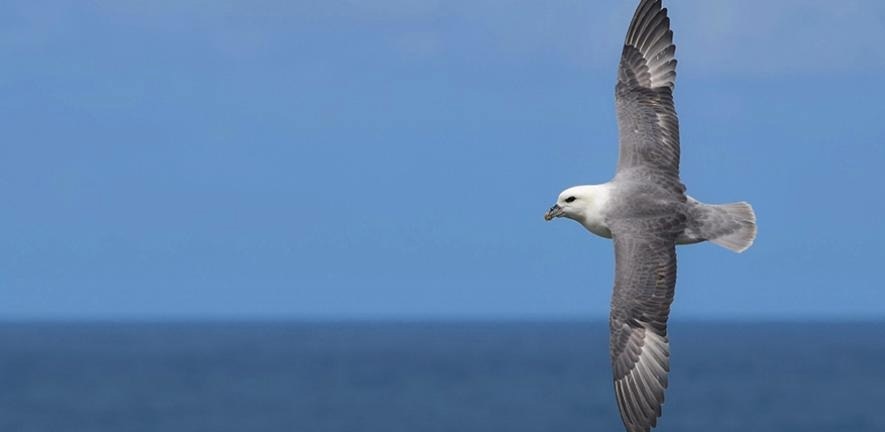An analysis of global tracking data for 77 petrel species revealed that a quarter of plastic exposure encounters for these birds occur at high seas, necessitating an international effort to address plastic pollution.
 Northern Fulmar bird in flight. Image Credit: Beth Clark
Northern Fulmar bird in flight. Image Credit: Beth Clark
The comprehensive review tracked the movements of 7,137 individual birds from 77 petrel species, a group of widely distributed migratory seabirds that includes the critically endangered Northern Fulmar and European Storm-petrel, and also the Critically Endangered Newell’s Shearwater.
This is the first-time tracking data from so many seabird species have been combined and superimposed on global maps of plastic distribution in the oceans.
The findings show that plastic pollution endangers marine life on a global scale: a quarter of all plastic exposure risk occurs in the high seas. This is largely due to gyres, which are large systems of rotating ocean currents that are fed by waste entering the sea from boats and many different countries.
Seabirds frequently confuse small plastic fragments for food or consume plastic that has already been consumed by their prey. This can result in injury, poisoning, and starvation, and petrels are especially vulnerable because the plastic is difficult to regurgitate. In the breeding season, they accidentally feed plastic to their chicks.
Toxic chemicals found in plastics can be harmful to seabirds.
Petrels are a susceptible but underexplored group of marine species that play an important role in oceanic food webs. Because of their widespread distribution across the ocean, they serve as important “sentinel species” in considering the risks of plastic pollution in the marine environment.
Ocean currents cause big swirling collections of plastic rubbish to accumulate far from land, way out of sight and beyond the jurisdiction of any one country. We found that many species of petrel spend considerable amounts of time feeding around these mid-ocean gyres, which puts them at high risk of ingesting plastic debris.
Lizzie Pearmain, Study Joint Corresponding Author and Ph.D. Student, Department of Zoology, University of Cambridge
Lizzie Pearmain is also associated with the British Antarctic Survey.
Lizzie Pearmain adds, “When petrels eat plastic, it can get stuck in their stomachs and be fed to their chicks. This leaves less space for food, and can cause internal injuries or release toxins.”
Climate change, bycatch, competition with fisheries, and invasive species like mice and rats on breeding colonies are already threatening the extinction of petrels and other species. According to the investigators, plastic exposure may decrease the birds’ resilience to these other threats.
Plenty of threatened seabird species forage in mid-ocean gyres of plastic waste in the north-east Pacific, South Atlantic, and south-west Indian oceans.
Even species with low exposure risk have been found to eat plastic. This shows that plastic levels in the ocean are a problem for seabirds worldwide, even outside of these high exposure areas.
Dr. Bethany Clark, Study Joint Corresponding Author, Seabird Science Officer, BirdLife International
Dr. Bethany Clark notes, “Many petrel species risk exposure to plastic in the waters of several countries and the high seas during their migrations. Due to ocean currents, this plastic debris often ends up far away from its original source. This highlights the need for international cooperation to tackle plastic pollution in the world’s oceans.”
The research also revealed that the Mediterranean and Black Seas account for more than half of the global plastic exposure risk for petrels—only four species of petrel forage in these congested, enclosed areas.
The research is guided by a collaboration between the University of Cambridge, BirdLife International, and the British Antarctic Survey, as well as Fauna & Flora International, the 5 Gyres Institute, and over 200 seabird researchers from 27 countries.
The study was published in the journal Nature Communications.
The researchers obtained their findings by superimposing global location data from tracking devices attached to the birds onto pre-existing maps of marine plastic distribution. This enabled them to pinpoint the locations on the birds’ migration and foraging routes where they are most likely to come into contact with plastic.
Species were assigned an “exposure risk score” to indicate their likelihood of encountering plastic at sea. Several already threatened species received high scores, including the Critically Endangered Balearic Shearwater, which breeds in the Mediterranean, and the endemic to Hawaii Newell’s Shearwater.
The Hawaiian Petrel, another Endangered species, also scored high for plastic exposure risk, as did three species classified by the IUCN as Vulnerable: The Yelkouan Shearwater, which breeds in the Mediterranean; Cook’s Petrel, which breeds in New Zealand; and the Spectacled Petrel, which breeds only on an extinct volcano known as Inaccessible Island, part of the Tristan da Cunha archipelago, a UK Overseas Territory.
While the population-level effects of plastic exposure are not yet known for most species, many petrels and other marine species are already in a precarious situation. Continued exposure to potentially dangerous plastics adds to the pressures.
Andrea Manica, Study Co-Author and Professor, Department of Zoology, University of Cambridge
Andrea Manica concludes, “This study is a big leap forward in understanding the situation, and our results will feed into conservation work to try and address the threats to birds at sea.”
The Cambridge Conservation Initiative’s Collaborative Fund for Conservation, which is supported by the Prince Albert II of Monaco Foundation and the Natural Environment Research Council, funded the study.
Journal Reference:
Clark, B. L., et al. (2023). Global assessment of marine plastic exposure risk for oceanic birds. Nature Communications. doi.org/10.1038/s41467-023-38900-z.